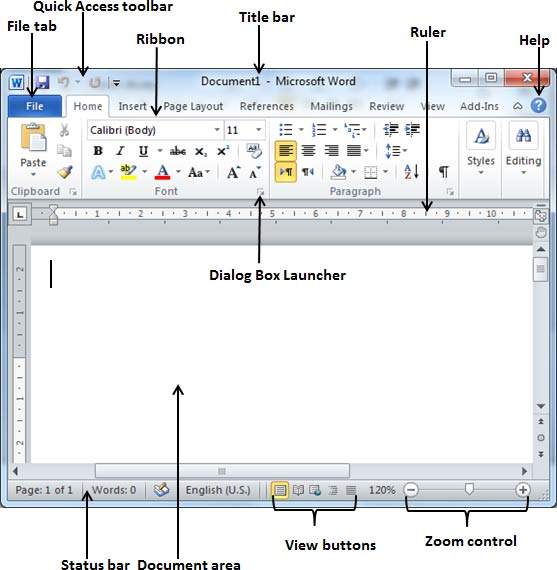In this chapter, we will understand how to explore Window in Word
2010. Following is the basic window which you get when you start the
Word application. Let us understand the various important parts of this
window..

File Tab
The File tab replaces the Office button from Word 2007. You can click it to check the
Backstage view.
This is where you come when you need to open or save files, create new
documents, print a document, and do other file-related operations.
Quick Access Toolbar
This you will find just above the
File tab. This is a
convenient resting place for the mostfrequently used commands in Word.
You can customize this toolbar based on your comfort.
Ribbon

Ribbon contains commands organized in three components −
- Tabs − These appear across the top of the Ribbon and
contain groups of related commands. Home, Insert, Page Layout are
examples of ribbon tabs.
- Groups − They organize related commands; each group name
appears below the group on the Ribbon. For example, group of commands
related to fonts or group of commands related to alignment, etc.
- Commands − Commands appear within each group as mentioned above.
Title bar
This lies in the middle and at the top of the window. Title bar shows the program and document titles.
Rulers
Word has two rulers - a horizontal ruler and a vertical ruler. The
horizontal ruler appears just beneath the Ribbon and is used to set
margins and tab stops. The vertical ruler appears on the left edge of
the Word window and is used to gauge the vertical position of elements
on the page.
Help
The
Help Icon can be used to get word related help anytime you like. This provides nice tutorial on various subjects related to word.
Zoom Control
Zoom control lets you zoom in for a closer look at your text. The
zoom control consists of a slider that you can slide left or right to
zoom in or out; you can click the + buttons to increase or decrease the
zoom factor.
View Buttons
The group of five buttons located to the left of the Zoom control,
near the bottom of the screen, lets you switch through the Word's
various document views.
- Print Layout view − This displays pages exactly as they will appear when printed.
- Full Screen Reading view − This gives a full screen view of the document.
- Web Layout view − This shows how a document appears when viewed by a Web browser, such as Internet Explorer.
- Outline view − This lets you work with outlines established using Word’s standard heading styles.
- Draft view − This formats text as it appears on the
printed page with a few exceptions. For example, headers and footers
aren't shown. Most people prefer this mode.
Document Area
This is the area where you type. The flashing vertical bar is called
the insertion point and it represents the location where text will
appear when you type.
Status Bar
This displays the document information as well as the insertion point
location. From left to right, this bar contains the total number of
pages and words in the document, language, etc.
You can configure the status bar by right-clicking anywhere on it and
by selecting or deselecting options from the provided list.
Dialog Box Launcher
This appears as very small arrow in the lower-right corner of many
groups on the Ribbon. Clicking this button opens a dialog box or task
pane that provides more options about the group.